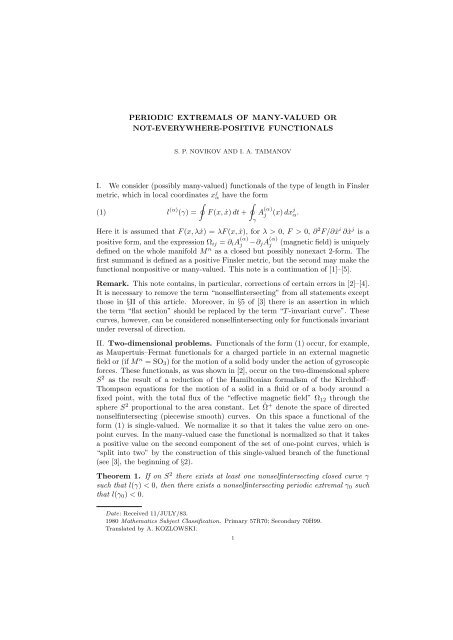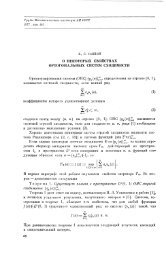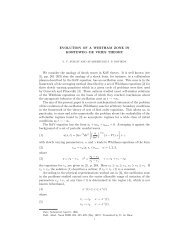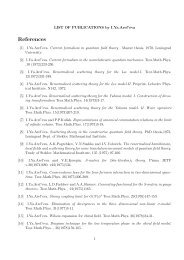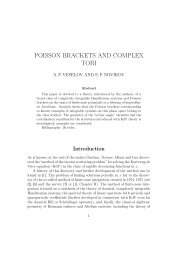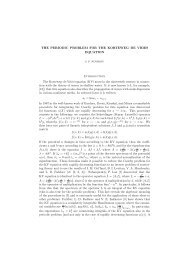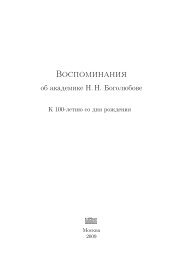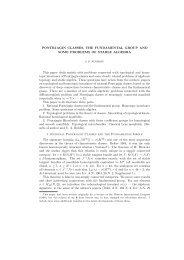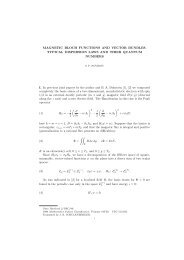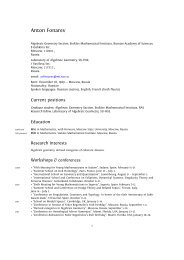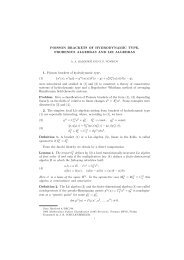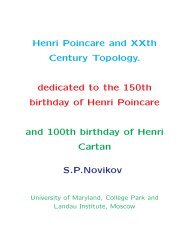Periodic extremals of many-valued or not everywhere positive ...
Periodic extremals of many-valued or not everywhere positive ...
Periodic extremals of many-valued or not everywhere positive ...
Create successful ePaper yourself
Turn your PDF publications into a flip-book with our unique Google optimized e-Paper software.
PERIODIC EXTREMALS OF MANY-VALUED OR<br />
NOT-EVERYWHERE-POSITIVE FUNCTIONALS<br />
S. P. NOVIKOV AND I. A. TAIMANOV<br />
I. We consider (possibly <strong>many</strong>-<strong>valued</strong>) functionals <strong>of</strong> the type <strong>of</strong> length in Finsler<br />
metric, which in local co<strong>or</strong>dinates x j α have the f<strong>or</strong>m<br />
∮<br />
∮<br />
(1) l (α) (γ) = F (x, ẋ) dt + A (α)<br />
j (x) dx j α.<br />
Here it is assumed that F (x, λẋ) = λF (x, ẋ), f<strong>or</strong> λ > 0, F > 0, ∂ 2 F/∂ẋ i ∂ẋ j is a<br />
<strong>positive</strong> f<strong>or</strong>m, and the expression Ω ij = ∂ i A (α)<br />
j −∂ j A (α)<br />
j (magnetic field) is uniquely<br />
defined on the whole manifold M n as a closed but possibly nonexact 2-f<strong>or</strong>m. The<br />
first summand is defined as a <strong>positive</strong> Finsler metric, but the second may make the<br />
functional non<strong>positive</strong> <strong>or</strong> <strong>many</strong>-<strong>valued</strong>. This <strong>not</strong>e is a continuation <strong>of</strong> [1]–[5].<br />
Remark. This <strong>not</strong>e contains, in particular, c<strong>or</strong>rections <strong>of</strong> certain err<strong>or</strong>s in [2]–[4].<br />
It is necessary to remove the term “nonselfintersecting” from all statements except<br />
those in §II <strong>of</strong> this article. M<strong>or</strong>eover, in §5 <strong>of</strong> [3] there is an assertion in which<br />
the term “flat section” should be replaced by the term “T -invariant curve”. These<br />
curves, however, can be considered nonselfintersecting only f<strong>or</strong> functionals invariant<br />
under reversal <strong>of</strong> direction.<br />
II. Two-dimensional problems. Functionals <strong>of</strong> the f<strong>or</strong>m (1) occur, f<strong>or</strong> example,<br />
as Maupertuis–Fermat functionals f<strong>or</strong> a charged particle in an external magnetic<br />
field <strong>or</strong> (if M n = SO 3 ) f<strong>or</strong> the motion <strong>of</strong> a solid body under the action <strong>of</strong> gyroscopic<br />
f<strong>or</strong>ces. These functionals, as was shown in [2], occur on the two-dimensional sphere<br />
S 2 as the result <strong>of</strong> a reduction <strong>of</strong> the Hamiltonian f<strong>or</strong>malism <strong>of</strong> the Kirchh<strong>of</strong>f–<br />
Thompson equations f<strong>or</strong> the motion <strong>of</strong> a solid in a fluid <strong>or</strong> <strong>of</strong> a body around a<br />
fixed point, with the total flux <strong>of</strong> the “effective magnetic field” Ω 12 through the<br />
sphere S 2 prop<strong>or</strong>tional to the area constant. Let ˆΩ + de<strong>not</strong>e the space <strong>of</strong> directed<br />
nonselfintersecting (piecewise smooth) curves. On this space a functional <strong>of</strong> the<br />
f<strong>or</strong>m (1) is single-<strong>valued</strong>. We n<strong>or</strong>malize it so that it takes the value zero on onepoint<br />
curves. In the <strong>many</strong>-<strong>valued</strong> case the functional is n<strong>or</strong>malized so that it takes<br />
a <strong>positive</strong> value on the second component <strong>of</strong> the set <strong>of</strong> one-point curves, which is<br />
“split into two” by the construction <strong>of</strong> this single-<strong>valued</strong> branch <strong>of</strong> the functional<br />
(see [3], the beginning <strong>of</strong> §2).<br />
The<strong>or</strong>em 1. If on S 2 there exists at least one nonselfintersecting closed curve γ<br />
such that l(γ) < 0, then there exists a nonselfintersecting periodic extremal γ 0 such<br />
that l(γ 0 ) < 0.<br />
γ<br />
Date: Received 11/JULY/83.<br />
1980 Mathematics Subject Classification. Primary 57R70; Secondary 70H99.<br />
Translated by A. KOZLOWSKI.<br />
1
2 S. P. NOVIKOV AND I. A. TAIMANOV<br />
Remark. This extremal may <strong>not</strong> be a minimum <strong>of</strong> the functional among nonselfintersecting<br />
curves. This is the point <strong>of</strong> an err<strong>or</strong> in §1 <strong>of</strong> [3].<br />
The<strong>or</strong>em 1 follows from the following lemmas.<br />
Lemma 1. If a minimum ¯γ <strong>of</strong> the functional l lying in the closure <strong>of</strong> the set <strong>of</strong><br />
nonselfinterecting curves is <strong>not</strong> a periodic extremal, then there exists a closed curve<br />
¯γ consisting <strong>of</strong> a single nonselfintersecting closed piece <strong>of</strong> an extremal containing<br />
one turning point (zero angle) with l(¯γ) < 0.<br />
Lemma 2. Given a functional <strong>of</strong> the f<strong>or</strong>m (1) on the plane and a convex extremal<br />
polygon ¯γ with all the angles between the links <strong>not</strong> greater than π (the zero angle is<br />
allowed) and l(¯γ) < 0, there exists within its interi<strong>or</strong> a smooth nonselfintersecting<br />
periodic extremal γ such that l(γ) < 0.<br />
The<strong>or</strong>em 2 follows from the fact that, due to the convexity, the sh<strong>or</strong>tening def<strong>or</strong>mations<br />
lead into the interi<strong>or</strong> <strong>of</strong> ¯γ.<br />
The<strong>or</strong>em 2. Suppose that on the t<strong>or</strong>us T 2 there is given a functional <strong>of</strong> the f<strong>or</strong>m<br />
(1), where the total flux <strong>of</strong> the field Ω 12 through T 2 (<strong>or</strong> a chamber in the plane R 2 )<br />
is nonzero. Then in the general case there exist at least 4 nondegenerate periodic<br />
<strong>extremals</strong> on R 2 (up to a translation by a vect<strong>or</strong> in the lattice Z + Z) with index<br />
1, 2, 2, 3 f<strong>or</strong> which the Whitney number is zero and l > 0.<br />
C<strong>or</strong>ollary 1. All these <strong>extremals</strong> are geometrically distinct, since the Whitney<br />
number <strong>of</strong> an iterated curve is nonzero.<br />
The pro<strong>of</strong> follows [3], §4.III (see the foot<strong>not</strong>e), starting from the “principle <strong>of</strong><br />
throwing out cycles”, in this case first f<strong>or</strong>mulated in [3]; f<strong>or</strong> its generalization see [5].<br />
However, in the process <strong>of</strong> def<strong>or</strong>mation “downwards” there appear selfintersecting<br />
curves, and only the Whitney number remains invariant.<br />
III.<br />
We turn now to arbitrary dimensions.<br />
Lemma 3. If a functional <strong>of</strong> the f<strong>or</strong>m (1) is single-<strong>valued</strong> and <strong>positive</strong> on the space<br />
<strong>of</strong> curves nullhomotopic in Ω + 1 (M n ), then it is semibounded and single-<strong>valued</strong> on<br />
all spaces <strong>of</strong> curves Ω + g (M n ) <strong>of</strong> arbitrary homotopy classes g (with a fixed starting<br />
point).<br />
If the functional is <strong>many</strong>-<strong>valued</strong> on some space Ω + g (M n ), g ≠ 1, then in Ω + g<br />
group π 1 is nontrivial. A map S 1 −→ ϕ Ω + g defines a map T 2 −→ f M n , f ∗ π 1 (T 2 ) ≠ 0,<br />
such that the flux <strong>of</strong> the magnetic field Ω ij through the cycle f(T 2 ) is nonzero. We<br />
obtain a map <strong>of</strong> coverings R 2 −→ ˆf ˆM n . The image ¯γ R = ˆf(γ R ) <strong>of</strong> a circle <strong>of</strong> radius<br />
R in R 2 as R → ∞ is a curve f<strong>or</strong> which l(¯γ R ) < 0. From this Lemma 3 follows<br />
easily. Hence we obtain<br />
The<strong>or</strong>em 3. On an arbitrary non-simply-connected manifold (closed) the functional<br />
(1) possesses at least one periodic extremal.<br />
F<strong>or</strong> the simply-connected case the the<strong>or</strong>em was obtained in [1].<br />
Condition. a) H 2k+1 (M n ; R) ≠ 0 f<strong>or</strong> some k.<br />
b) F<strong>or</strong> some g, g ≠ 1, the number <strong>of</strong> generat<strong>or</strong>s <strong>of</strong> π 1 (Ω + g (M n )) is <strong>not</strong> less than<br />
two and the class g 2m+1 does <strong>not</strong> coincide with g 2n f<strong>or</strong> any n, m 0.<br />
the
PERIODIC EXTREMALS OF MANY-VALUED FUNCTIONALS 3<br />
The<strong>or</strong>em 4. If the condition holds, then there exist at least two nondegenerate<br />
<strong>extremals</strong> <strong>of</strong> the functional (1) in general position on a closed manifold, which<br />
<strong>extremals</strong> are geometrically distinct and homotopic to each other.<br />
The existence <strong>of</strong> at least two generat<strong>or</strong>s in π 1 (Ω + g ) gives the existence <strong>of</strong> two<br />
<strong>extremals</strong> in Ω + g <strong>of</strong> index 0 and 1, if the functional is single-<strong>valued</strong> and semibounded<br />
on Ω + 1 . Otherwise, the functional is non<strong>positive</strong> on Ω+ 1 , where, theref<strong>or</strong>e, there<br />
exist geometrically distinct <strong>extremals</strong> <strong>of</strong> index 1 and 2k + 2 [5]. The claim that the<br />
<strong>extremals</strong> in Ω + g are geometrically distinct is proved using Bott’s the<strong>or</strong>em [6].<br />
References<br />
[1] S. P. Novikov, Dokl. Akad. Nauk SSSR 260 (1981), 31–35; English transl. in Soviet Math.<br />
Dokl. 24 (1981).<br />
[2] S. P. Novikov and I. Shmel’tser, Funktsional. Anal. i Prilozhen. 15 (1981), no. 3, 54–66; English<br />
transl. in Functional Anal. Appl. 15 (1981).<br />
[3] S. P. Novikov, Funktsional. Anal. i Prilozhen. 15 (1981), no. 4, 37–52; English transl. in<br />
Functional Anal. Appl. 15 (1981).<br />
[4] , Uspekhi Mat. Nauk 37 (1982), no. 5 (227), 3–49; English transl. in Russian Math.<br />
Surveys 37 (1982).<br />
[5] I. A. Taĭmanov, Dokl. Akad. Nauk SSSR 268 (1983), 46–50; English transl. in Soviet Math.<br />
Dokl. 27 (1983).<br />
[6] Raoul Bott, Comm. Pure Appl. Math. 9 (1956), 171–206.<br />
Landau Institute <strong>of</strong> The<strong>or</strong>etical Physics, Academy <strong>of</strong> Sciences <strong>of</strong> the USSR


